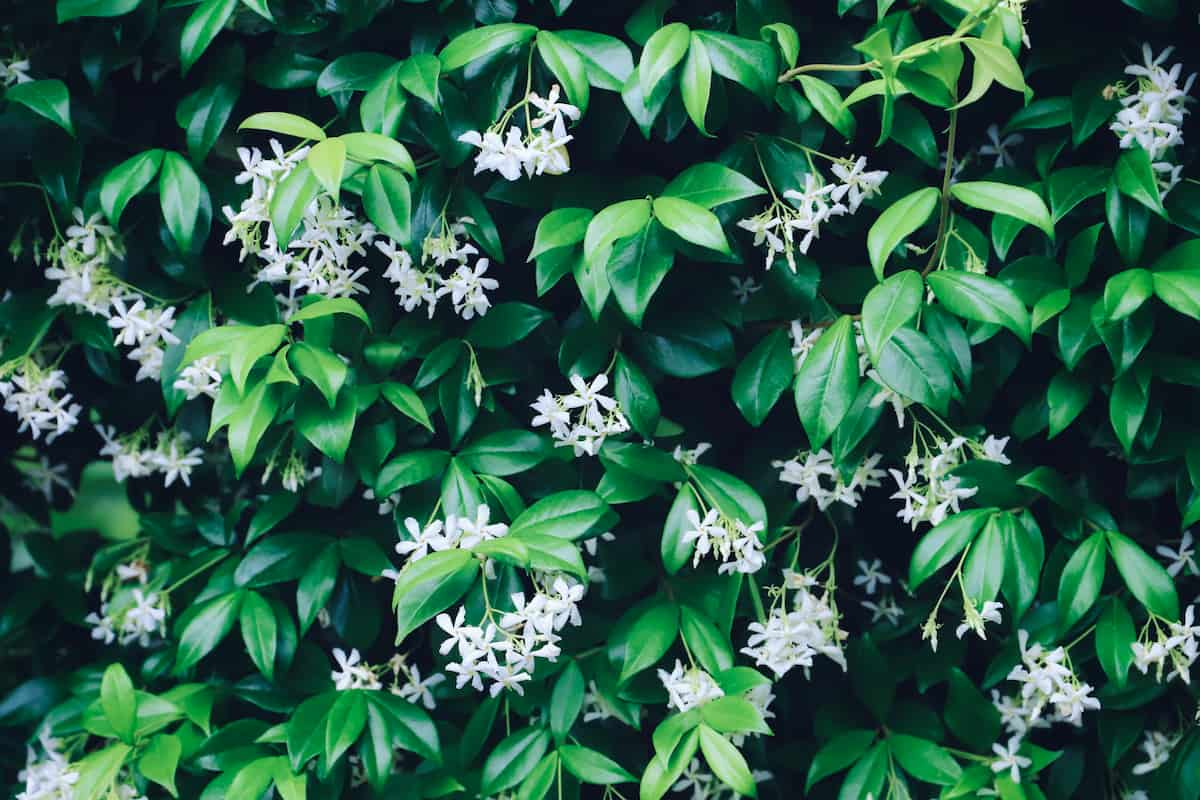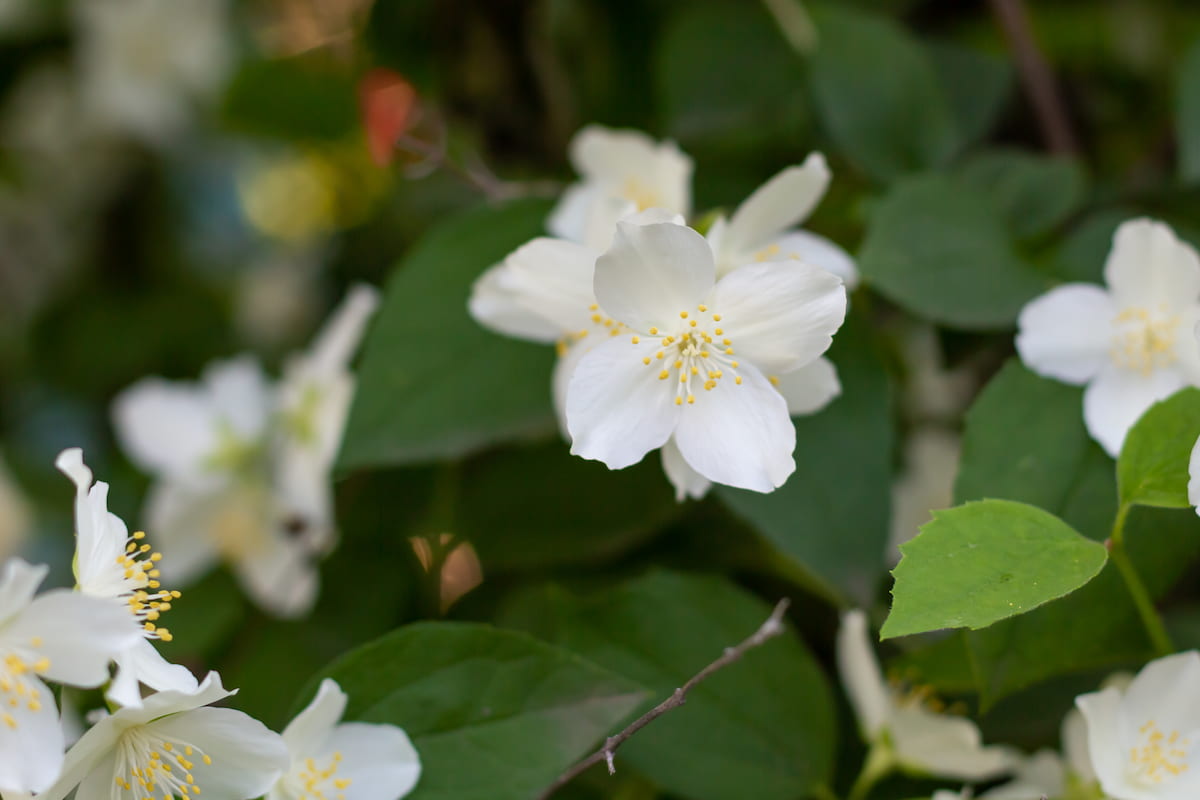The Jasmine plant is a climbing plant with twining stems that can be evergreen or deciduous. White, yellow, and occasionally red and pink flowers can be found on these plants, whether they bloom in summer or winter. Jasmines are characterized by their small, star-shaped flowers and sweet, distinctive fragrance.

Some tender plants should only be grown in a conservatory or greenhouse. The hardier varieties are perfect for greening up a wall or fence if they have wires to support them. Jasmine grows best in a sunny, warm, sheltered area, preferably near a seating area so you can enjoy the fragrance.
How to Grow Jasmine in Greenhouse
Jasmine Varieties
Approximately 200 different varieties of Jasmine are native to tropical climates, temperate climates, and warmer climates. Each Jasmine plant type will have slightly different needs, so knowing the varieties before planting is important.
- Arabian Jasmine: A shrub or vine, this variety of Jasmine is evergreen. The Arabian Jasmine grows to a height of 3-9 feet.
- White Jasmine: This variety grows 20-30 feet tall and 7-15 feet wide, so you will need ample space to grow it.
- Purple Jasmine: It is also known as the star Jasmine or purple Jasmine. The vine can reach 20 feet in height but can also be used as a hedge, shrub, or ground cover at a smaller scale.
- Forest Jasmine: Dark green glossy leaves and bright white flowers with a slight pink tinge distinguish forest Jasmine. The stems grow more than 5 inches in diameter, making them a strong variety.
- Winter Jasmine: Its striking yellow blooms make Winter Jasmine stand out against a trellis up to 15 feet high.
- Spanish Jasmine: As another highly scented variety, Spanish Jasmine grows as a deciduous climber or shrub widely used in perfumes. The plant can reach a height of 6-3 feet.
Soil Requirements to Grow Jasmine in Greenhouse
Soil with good drainage is preferable to Jasmine. Some cultivars prefer sandier soil than others. Clay soils are not recommended for growing Jasmine without serious amendments to lighten the soil content. The roots of the plant and the base of the plant will remain warmer with mulch in winter for zones 9-11. In the case of grafted plants, mulch for root warmth, but leave an indentation around the graft joint so it is not covered.
Temperature & Humidity Requirements to Grow Jasmine in Greenhouse
Ideally, Jasmine plants like cooler temperatures, thriving at 15°C to 24°C. Flower buds need to develop at cool temperatures in early fall. It is also sensitive to dry air, so avoid placing plants near radiators or air vents. A humidifier or trays filled with gravel, pebbles, and water can add humidity to plant pots. Keeping the water level below the stones on the tray will prevent the soil from sitting in water.
Propagating and Planting Jasmine from Cuttings
- You should choose healthy stems with lots of new growth of green leaves. It is recommended that the cutting has at least two leaves and one node. Cut a six-inch piece of stem with sharp pruners or scissors.
- The cutting should be stripped of all but one or two leaves. A soilless potting mix should be filled into a four-inch pot.
- You can increase the likelihood of successful rooting by dipping the cut ends in the rooting hormone.
- Make a hole using a pencil or stick slightly larger than the stem diameter in the soil. About three inches should be inserted into the hole from the cut end.
- The soil around it should be gently pressed down. If you want to grow more than one cutting in one pot, keep them apart.
- Place the cuttings in a warm, sunny area with high humidity and a steady but measured water supply. It should take a few weeks for new growth to appear.
- After the new plant has established a good root system, it can be transplanted into a larger pot or greenhouse.
- The hole should be twice as wide and as deep as the root ball for transplanting. After removing the shrub from the container, gently tease the roots and cut away any circles or tangles.
- Position in the hole and backfill with soil, firming down gently.
- A doughnut-shaped or raised ring of soil should surround the outer edge of the root zone.
- The plant base should be mulched with organic mulch like bark chips, woodchips, or pea straw, keeping it away from the roots.
- Water the plants once or twice a week, depending on the weather.
In case you missed it: How to Grow Dragon Fruit in a Greenhouse: A Step-By-Step Guide for Seed to Harvest

Watering Requirements to Grow Jasmine in Greenhouse
Water Jasmine flowers once a week if they are planted in the ground. Increase the frequency when the weather is unusually dry or hot, but let the soil dry between applications. Your Jasmine will likely need water multiple times weekly, especially during the summer. After the top inch of soil has dried, water it.
Fertilizer Requirements to Grow Jasmine in Greenhouse
Jasmine requires regular fertilization, so give it plenty of nutrients. When establishing a vine-covered arbor or a larger shrub, a higher nitrogen fertilizer helps Jasmine grow rapidly. Jasmine needs lots of phosphorous to develop its blossoms. If you don’t have a fertilizer ideally suited for Jasminum species, use a standard balanced fertilizer.
Pruning Jasmine Plants
If your plants have an explosion of growth during warm weather, you may have to prune aggressively. Vining varieties should be trained on their supports, and weaker vines should be secured. Trim vines to promote forking by pinching off excess vines. Maintain the size and shape of a shrub by pruning. Ensure the plant has enough surface area for photosynthesis so you don’t prune too much. If you are growing Jasmine as a hedge plant, encourage bushy growth. Maintain its size by pinching or trimming excess growth as it grows.
Common Pests, Diseases, and Their Control in Jasmine Plants
Root-knot nematodes, mealybugs, and whiteflies are the most common pests of Jasmine species. Beneficial nematodes should help you eradicate nematodes from your plants’ soil since they are the most difficult to eradicate. Most other insects can be controlled with the application of neem oil.
A blight, rust, and Fusarium wilt are the most common diseases of Jasmine. Infected soil may make prevention easier than treatment. Watering the plant from the top should be avoided, and prune it to promote circulation so the leaves and stems remain dry. Use a copper fungicide if your plant is affected by these diseases.
Harvesting Jasmine
Six months after planting, the plants begin to flower. Nevertheless, commercial yields are taken from the third year onwards. Fresh flowers are picked from fully developed, unopened flower buds early in the morning. It is essential to handle the flowers carefully during harvest and transportation.
In case you missed it: How to Grow Cloves in a Greenhouse: A Step-by-Step Guide for Seed to Harvest

Conclusion
One of the most popular and well-known flowers for its excellent fragrance is Jasmine. Therefore, they are always in demand in industries, especially for their excellent fragrance. Thousands of small farmers prefer Jasmine farming over fruit and vegetable farming. Various methods are available for growing them, such as open fields, greenhouses, and poly houses.
- Feed Your Flock for Less: Top 10 Tips to Save on Chicken Feed
- Ultimate Guide to Ossabaw Island Hog: Breeding, Raising, Diet, and Care
- Hatching Answers: The Top 10 Reasons Your Chickens Aren’t Laying Eggs
- Eggs and Economics: Breaking Down the Cost of Raising Backyard Chickens
- Defend Your Greens: Proven Methods to Keep Iguanas Out of Your Garden
- Ultimate Guide to Cinnamon Queen Chicken: A Comprehensive Guide for Beginners
- Ultimate Guide to California Tan Chicken: Breeding, Raising, Diet, Egg-Production and Care
- Ultimate Guide to Marsh Daisy Chicken: Breeding, Raising, Diet, and Care
- 10 Types of Chicken Farming Businesses You Can Start for Profits